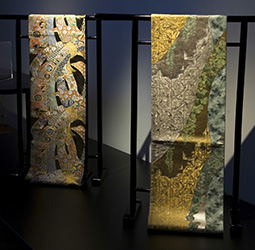INDEX
- English
- 日本語

Nishijin textiles made by HOSOO Co. are used in the interior design of many luxury hotels, including The Ritz-Carlton Tokyo - English
- 日本語

Ori-no-hibiki produces sound when the fabric is touched

The obi sash displayed at the Kansei-Japan Design Exhibition in Paris, 2008
September 2020
The New Traditions of Nishijin Textiles

Nishijin, a part of Kyoto famous for the namesake textiles that are representative of Japan, has passed on the textile tradition for more than 1,200 years. In Nishijin, a weaver with more than 300 years of history is producing unprecedented Nishijin textiles through new techniques and collaborations with various artists, attracting a lot of attention both from within Japan and from overseas.

Nishijin is a district of Kyoto where narrow alleyways are lined with traditional long and narrow buildings built in the Machiya-zukuri architectural style. The silk textiles that have traditionally been produced in this district are called Nishijin textiles. The textiles are characterized by their colorful and elaborate patterns.
“Nishijin textile makers have pursued beauty while meeting the demands of the imperial court, aristocracy, temples, shrines and other customers mostly in Kyoto, which was the capital of Japan for over 1,000 years,” says Hosoo Masataka, the 12th-generation family head and president & CEO at HOSOO Co., Ltd. The company has manufactured Nishijin textiles and conducted wholesale trading since its founding in 1688.
In Nishijin, weavers, dyers, thread makers and craftsmen creating the gold and silver leaf characteristic of Nishijin textiles are mostly gathered within an area measuring just 5 km square. The division of labor at each of the more than twenty highly technical steps needed to complete Nishijin textiles has continued in this district for more than 1,200 years.
While HOSOO Co. continues to make traditional Nishijin textiles, it also has announced various textiles in the last ten years that have surprised the world, and continues to expand the possibilities of Nishijin textiles.

What started this trend was an exhibition at the Kansei-Japan Design Exhibition held in Paris in 2008. At this exhibition, American architect Peter Marino saw an obi sash made by HOSOO Co., and was moved by the sophistication of the weaving technique and the fabric’s gorgeous decorative quality. He saw potential for the textiles to be used as a material for interior design, and requested HOSOO Co. to create a fabric for interior design purposes. However, the width of Nishijin textiles is traditionally 32 cm, which is too narrow for use as an interior design material. To meet his request, the company developed a new loom and began to weave fabric with a width of 150 cm, which is an international standard for textiles. Produced by Marino, the new Nishijin textile fabric has come to be used for wallpaper, curtains and sofa upholstery in stores and hotels in over 100 cities around the world, including the flagship Christian Dior store in Paris.
Approximately 9,000 warp threads can be woven with the new loom, which is compatible with a width of 150 cm, and a three-dimensional textile can be woven with many layers. The loom can weave a variety of materials and can be adjusted to determine the fabric’s radiance, translucence and three-dimensional effects. Making use of this technology, HOSOO Co. collaborates with various artists and corporations. For example, in collaboration with American contemporary artist Teresita Fernández, the company took about one year to weave her artwork Nishijin Sky. The textile appears translucent from one side by making use of a weaving technique used for summer clothing called sha (silk gauze) and by angling the weave in a certain way. The beautiful fabric produced has “two distinct faces,” which is the concept behind the artwork.
In collaboration with Panasonic Corporation, a manufacturer of electrical appliances including audio equipment, HOSOO Co. created Ori-no-hibiki, a speaker that combines Nishijin textiles with cutting-edge technology. In addition to functioning as a speaker, it is designed to produce sounds when the fabric is touched with or approached by the hand. This speaker, which is activated by conductive metal threads woven into the fabric, was awarded the Best Storytelling Award at Milan Salone 2017.
Hosoo says, “Traditions evolve by cooperating with various fields and actively incorporating state-of-the-art technology. If we look back at the long history of Nishijin, perhaps our predecessors also continued to take on these kinds of challenge.”
Up until now, talk of Nishijin textiles centered around kimono, but HOSOO Co. launched an original brand, HOSOO, in 2019, and it is developing products as part of this “new tradition.” It has expanded the use of Nishijin textiles to all parts of modern life, from sofas and curtains used in homes and offices to pouches and small items, all made using original textiles. As HOSOO Co. intended, the elegant aesthetic sense of Kyoto, built up over 1,200 years, is present in each of these products.

